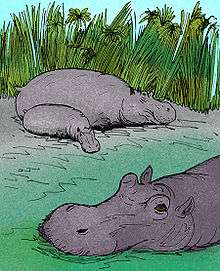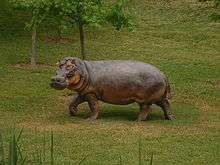Hippopotamus gorgops
Hippopotamus gorgops is an extinct species of hippopotamus. It first appeared in Africa during the late Pliocene, and eventually migrated into Europe during the early Pleistocene (where its fossils were first discovered). It became extinct during the Middle Pleistocene.[1]
| Hippopotamus gorgops | |
|---|---|
 | |
| Scientific classification | |
| Kingdom: | Animalia |
| Phylum: | Chordata |
| Class: | Mammalia |
| Order: | Artiodactyla |
| Family: | Hippopotamidae |
| Genus: | Hippopotamus |
| Species: | †H. gorgops |
| Binomial name | |
| †Hippopotamus gorgops Dietrich, 1928 | |
Taxonomy

With an estimated length of 4.3 metres (14 ft), a shoulder height of 2.1 metres (6.9 ft), and a weight of 3900-4500 kg (8600-9900 lb), H. gorgops was larger than its living relative, H. amphibius. Another feature setting it apart from H. amphibius was the placement of its eyes. Modern hippos have eyes placed high on the skull, but H. gorgops had eyestalk-like orbits extruding above its skull, making it even easier for the creature to see its surroundings while (almost) fully under water.[2] This species was described by German scientist Wilhelm Otto Dietrich in 1928.[3]
References
- Turner, Alan. National Geographic Prehistoric Mammals. National Geographic, 2004.
- Palmer, D., ed. (1999). The Marshall Illustrated Encyclopedia of Dinosaurs and Prehistoric Animals. London: Marshall Editions. p. 268. ISBN 1-84028-152-9.
- Dietrich, W. O. (1928). Pleistocäne Deutsch–Ostafrikanische Hippopotamus–reste. Wissenschaftliche Ergebnisse des Oldoway Expedetion Herausgeben Von Prof. Dr. Reck, 3: 3–41.
- Petronio, C. (1995): Note on the taxonomy of Pleistocene hippopotamuses. Ibex 3: 53–55. PDF fulltext